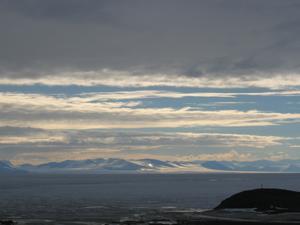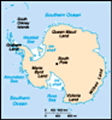Advertisement
Published: February 14th 2005

 Mountains & Glaciers
Mountains & Glaciers
This is a picture of the Royal Society Range and one of the glaciers flowing into McMurdo sound. The lighting is getting more interesting, which means winter is approaching.Hello from Antarctica! The sun has started its decent in the sky - a sign that winter is approaching. McMurdo Station has quieted down, vessel off-load is complete and the supply vessel and the icebreakers have gone home for the year leaving a large open-water channel in the ice, which has attracted some wildlife. Every day at the water’s edge there have been seals lounging, lethargically on the ice. I have been told that, due to the open water, this is one of the best times of year to see animals, but they will have to hurry as the ice is slowly freezing over again - Still no penguins.
Sunday was overcast, but not too cold. I decided to spend my day-off hiking out to Williams Field, which is the main airport for ski equipped airplanes and is the hub for flights to the south poll and many field camps that can’t be reached by helicopter. My route passed by Scott Base, New Zealand’s research station, and then followed a flagged ice road pass several icefalls and pressure ridges and then out to the airport - a walk of five miles. Scott Base has several buildings, all painted a bright

 Scott Base, Ross Island
Scott Base, Ross Island
Here is Scott Base, New Zealand's main research station in Antarctica. They are close neighbors to McMurdo Station being less than two miles away.green color, and occupies a small peninsula like outcrop of Ross Island. Near Scott Base a combination of tidal surges and other ice dynamics where the ice shelf meets with the land have created large, jumbled blocks of ice, jutting out of the water in several places - these are called pressure ridges. The pressure ridges are off-limits, but they are close enough to see several seals that have taken advantage of the broken ice to give them a haul-out point from the water below. These seals live there year round, keeping holes in the ice open using their teeth in the winter. I have been told that penguins occasionally join the seals there, but I didn’t see any. The area where the road transitions from land to ice is very slippery and full of cracks, which forces you to walk carefully - despite my being careful, I still slipped several times, but I didn’t fall down. The road winds around the edge of the transition zone between land and shelf ice and then heads straight across the ice toward the airfield; passing the place I went to happy camper school. One of the strange things about walking across the

 The Presure Ridges
The Presure Ridges
The presure ridges are created by the tidal surges and are favorite places for seals to haul out of the ocean.large, flat expanses of the ice shelf is you can see your destination, but, though it looks close, it seems like you never make any progress - kind of like walking up a down escalator. The scenery along this hike is amazing - Mt Erebus and Mt Terror, both on Ross Island, occupy the horizon to my left, the seemingly endless ice shelf stretches out in front of me, broken only by White Island, Mina Bluffs and Black Island and rising to my right, on the far side of McMurdo Sound is the steep, dome-shaped summit of Mt Discovery and the Royal Society Range with its multitude of jagged, beautiful, snow covered peaks. The summits on Ross Island were shrouded in clouds and the sky was grey above, but the peaks to my right were basking in sunlight. I had planned for cold conditions out on the ice shelf and I dressed accordingly, but I ended up being too hot and I had to carry my coat to keep from sweating. I finally arrived at Willy Field, as it’s called by most here, two hours after leaving McMurdo - The trail guide said it should take a very active person

 Williams Field
Williams Field
Willy Field is the main runway for ski-equipped planes. The three C-130 Hercules planes are used to take cargo and people to the South Pole and back.three hours, which doesn’t make any sense to me. There were three ski-equipped, C-130 Hercules airplanes there, which are the only current means of getting cargo to the south pole station, and several twin otters - all preparing to go home for the winter. There happened to be a shuttle that was just leaving when I got there, so, instead of walking back, I jumped aboard and got a free ride back to town, stopping along the way to pick up a large group from the Italian Antarctic Program.
Monday was a day that would be considered a nice day almost anywhere in the world. The temperature was around freezing, the sun was shining and the air was still. I decided to take advantage of the strange weather by taking another walk, this time out to Hut Point. I was hoping to see some wildlife because there was some open water just below Vince’s Cross. At first I was disappointed, but as I looked a little closer I saw a seal, well camouflaged on the dirty ice, laying about twenty feet from me. The seal was a Weddell Seal and they live around openings in the ice year round

 Oh, My Belly Itches!
Oh, My Belly Itches!
This is a Weddell Seal Scratching its belly.- they are the most common seal in the area. I watched it for about two hours as I waited for it to turn on to its belly and pose for the camera. The seal was very un-cooperative as far as the pictures go, but the show was great - the seal would roll around and scratch its belly and chin with its flipper, all while making whistling sounds and grunts that reminded me of a whale’s song. While I was watching the seal, another one stuck its head out of a small hole in the slushy ice to get some air - very neat! I will continue watching the area over the next few weeks, so hopefully I will get lucky and see some penguins. Well, that’s it for now.
Advertisement
Tot: 0.039s; Tpl: 0.012s; cc: 7; qc: 24; dbt: 0.0194s; 1; m:domysql w:travelblog (10.17.0.13); sld: 1;
; mem: 1mb










D MJ Binkley
Dave and Merry Jo Binkley
Oh this is great!
I will be reading all of your McMurdo blogs this weekend. Can't wait to revisit the lands of my past.